Customer Experience Optimization: Hilton Hotel Analysis and Strategy
VerifiedAdded on 2023/01/05
|9
|2679
|79
Report
AI Summary
This report provides a comprehensive analysis of Hilton Hotel's customer experience management. It begins by defining customer experience and its importance, then delves into Hilton's market segmentation strategies, including demographic, geographic, and psychographic approaches. The report emphasizes the significance of understanding customer needs, wants, and preferences, and how Hilton utilizes customer behavior and attitudes to build brand loyalty and trust. It reviews the factors driving customer engagement across different target groups and evaluates their specific needs and expectations. A key component is the definition and application of a customer experience map, charting the customer journey from travel inspiration to post-stay feedback. The report concludes with a discussion and analysis of how Hilton Hotel optimizes each customer touchpoint to enhance the overall guest experience, including providing excellent customer service, loyalty programs and discounts.
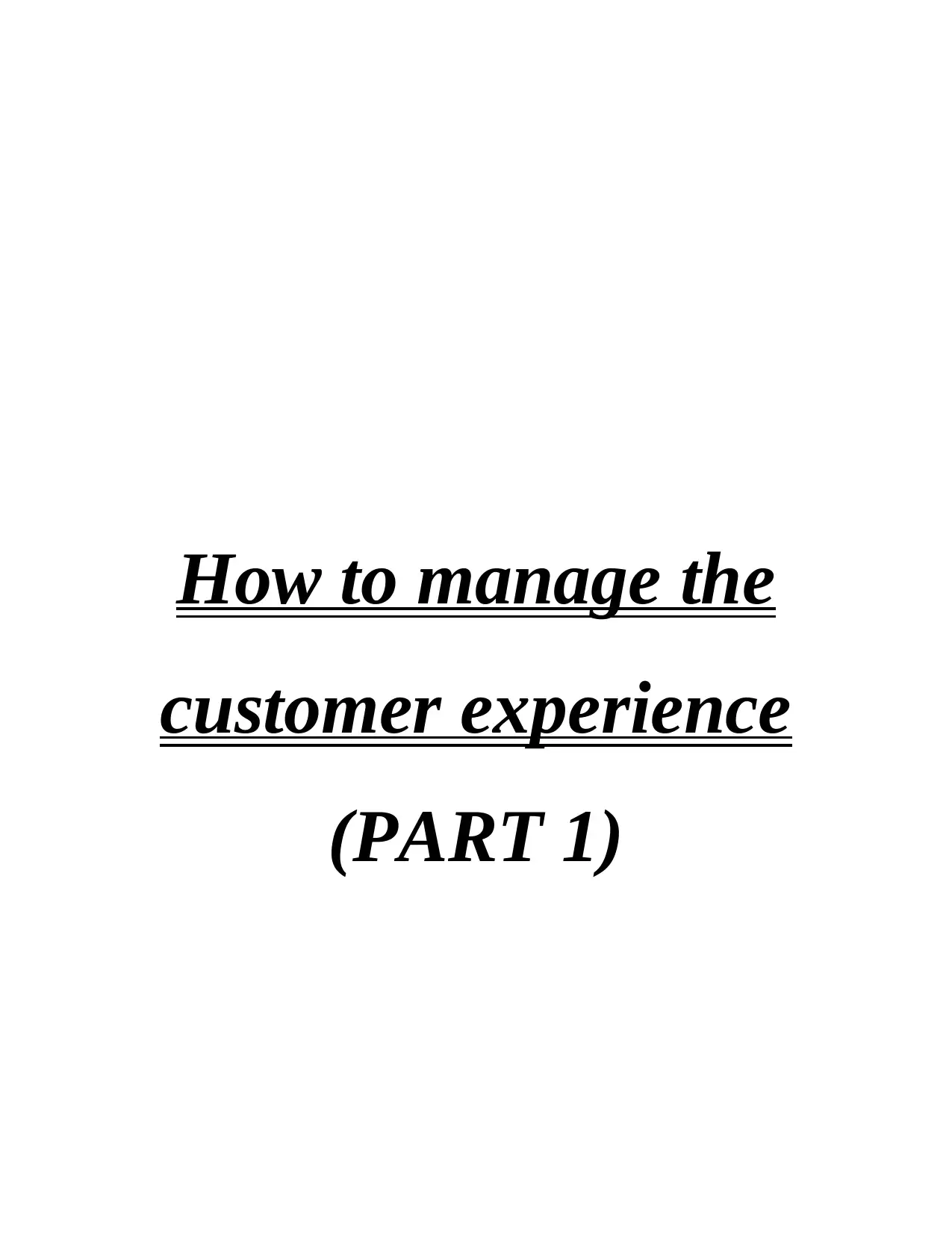
How to manage the
customer experience
(PART 1)
customer experience
(PART 1)
Paraphrase This Document
Need a fresh take? Get an instant paraphrase of this document with our AI Paraphraser
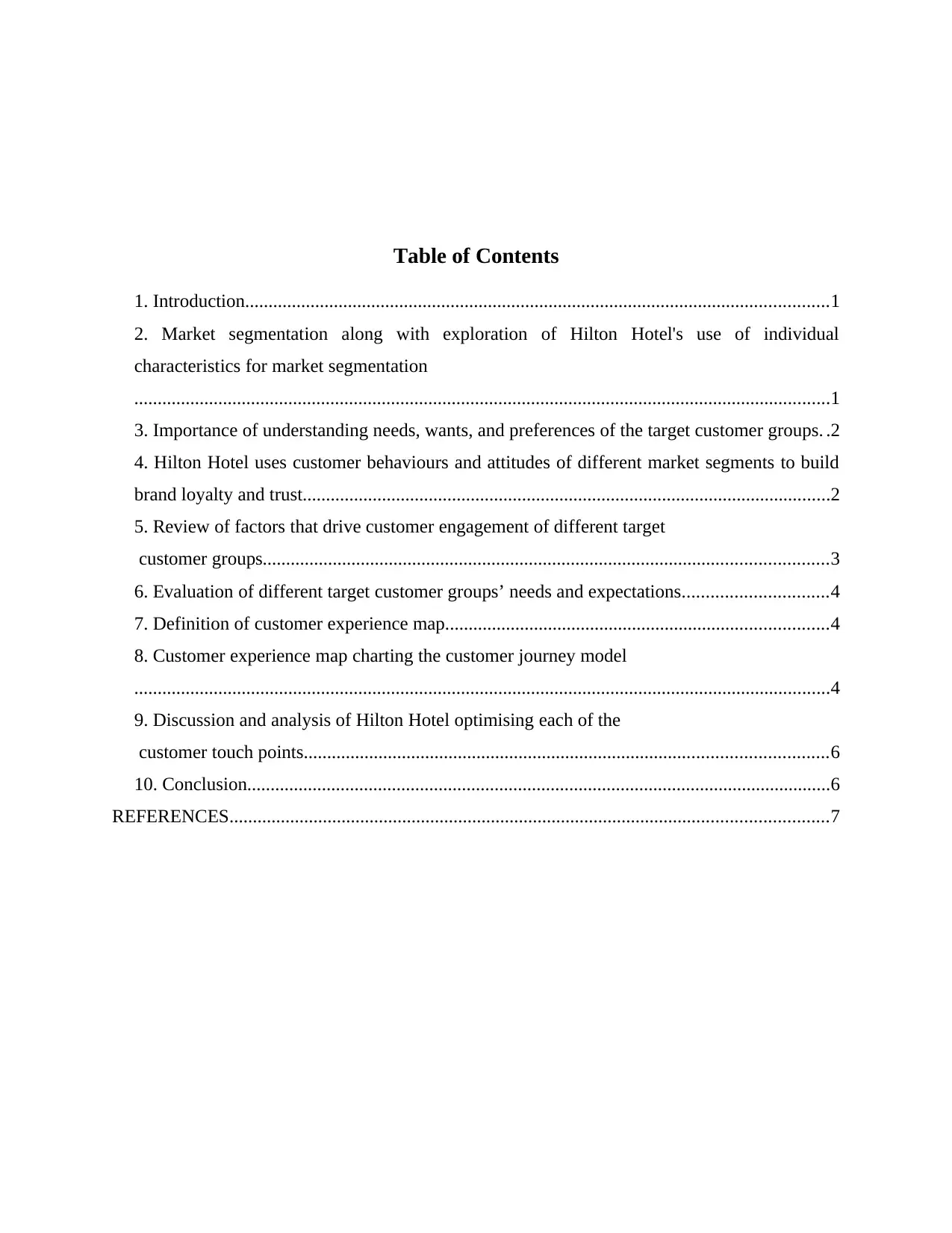
Table of Contents
1. Introduction.............................................................................................................................1
2. Market segmentation along with exploration of Hilton Hotel's use of individual
characteristics for market segmentation
.....................................................................................................................................................1
3. Importance of understanding needs, wants, and preferences of the target customer groups. .2
4. Hilton Hotel uses customer behaviours and attitudes of different market segments to build
brand loyalty and trust.................................................................................................................2
5. Review of factors that drive customer engagement of different target
customer groups.........................................................................................................................3
6. Evaluation of different target customer groups’ needs and expectations...............................4
7. Definition of customer experience map..................................................................................4
8. Customer experience map charting the customer journey model
.....................................................................................................................................................4
9. Discussion and analysis of Hilton Hotel optimising each of the
customer touch points................................................................................................................6
10. Conclusion.............................................................................................................................6
REFERENCES................................................................................................................................7
1. Introduction.............................................................................................................................1
2. Market segmentation along with exploration of Hilton Hotel's use of individual
characteristics for market segmentation
.....................................................................................................................................................1
3. Importance of understanding needs, wants, and preferences of the target customer groups. .2
4. Hilton Hotel uses customer behaviours and attitudes of different market segments to build
brand loyalty and trust.................................................................................................................2
5. Review of factors that drive customer engagement of different target
customer groups.........................................................................................................................3
6. Evaluation of different target customer groups’ needs and expectations...............................4
7. Definition of customer experience map..................................................................................4
8. Customer experience map charting the customer journey model
.....................................................................................................................................................4
9. Discussion and analysis of Hilton Hotel optimising each of the
customer touch points................................................................................................................6
10. Conclusion.............................................................................................................................6
REFERENCES................................................................................................................................7
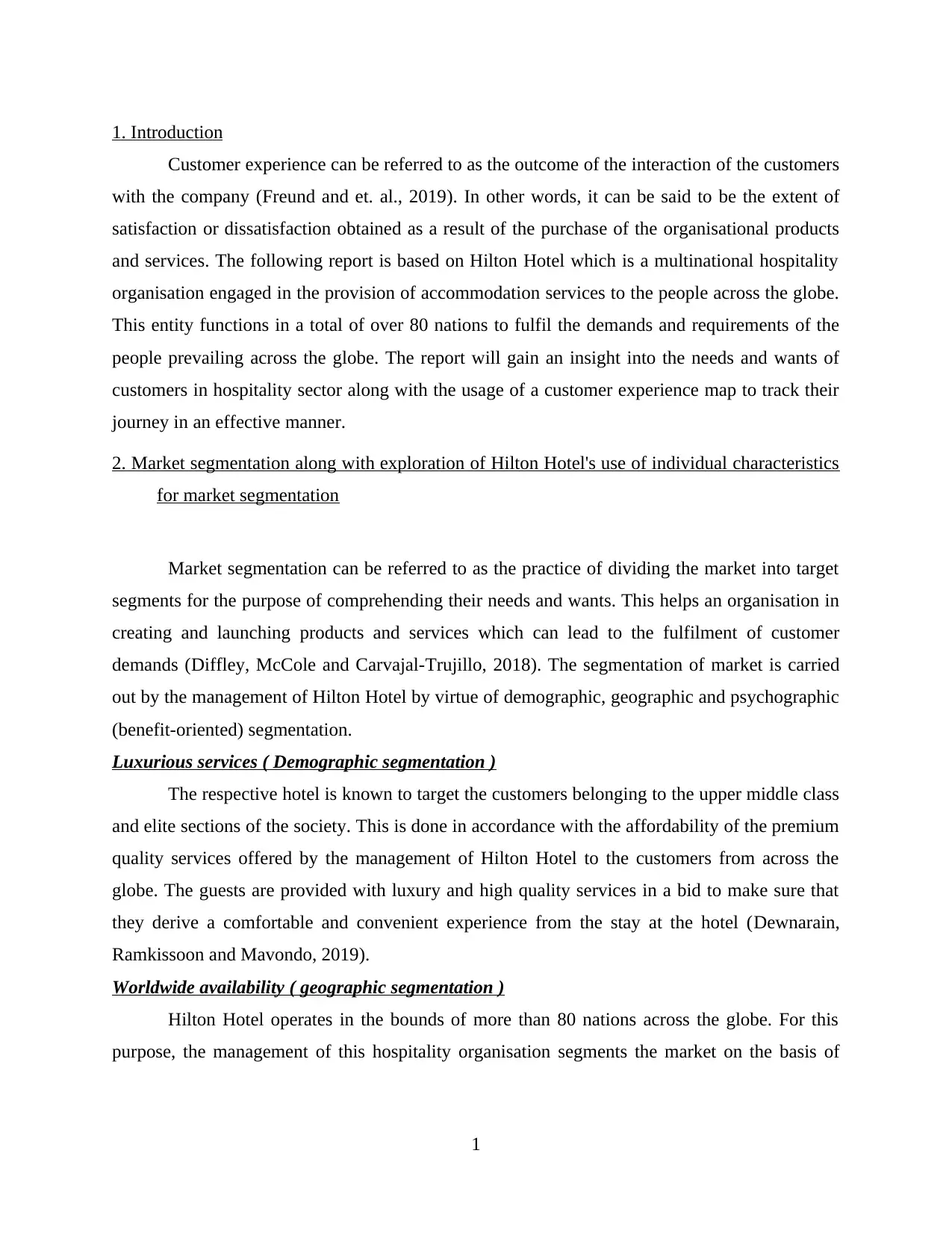
1. Introduction
Customer experience can be referred to as the outcome of the interaction of the customers
with the company (Freund and et. al., 2019). In other words, it can be said to be the extent of
satisfaction or dissatisfaction obtained as a result of the purchase of the organisational products
and services. The following report is based on Hilton Hotel which is a multinational hospitality
organisation engaged in the provision of accommodation services to the people across the globe.
This entity functions in a total of over 80 nations to fulfil the demands and requirements of the
people prevailing across the globe. The report will gain an insight into the needs and wants of
customers in hospitality sector along with the usage of a customer experience map to track their
journey in an effective manner.
2. Market segmentation along with exploration of Hilton Hotel's use of individual characteristics
for market segmentation
Market segmentation can be referred to as the practice of dividing the market into target
segments for the purpose of comprehending their needs and wants. This helps an organisation in
creating and launching products and services which can lead to the fulfilment of customer
demands (Diffley, McCole and Carvajal-Trujillo, 2018). The segmentation of market is carried
out by the management of Hilton Hotel by virtue of demographic, geographic and psychographic
(benefit-oriented) segmentation.
Luxurious services ( Demographic segmentation )
The respective hotel is known to target the customers belonging to the upper middle class
and elite sections of the society. This is done in accordance with the affordability of the premium
quality services offered by the management of Hilton Hotel to the customers from across the
globe. The guests are provided with luxury and high quality services in a bid to make sure that
they derive a comfortable and convenient experience from the stay at the hotel (Dewnarain,
Ramkissoon and Mavondo, 2019).
Worldwide availability ( geographic segmentation )
Hilton Hotel operates in the bounds of more than 80 nations across the globe. For this
purpose, the management of this hospitality organisation segments the market on the basis of
1
Customer experience can be referred to as the outcome of the interaction of the customers
with the company (Freund and et. al., 2019). In other words, it can be said to be the extent of
satisfaction or dissatisfaction obtained as a result of the purchase of the organisational products
and services. The following report is based on Hilton Hotel which is a multinational hospitality
organisation engaged in the provision of accommodation services to the people across the globe.
This entity functions in a total of over 80 nations to fulfil the demands and requirements of the
people prevailing across the globe. The report will gain an insight into the needs and wants of
customers in hospitality sector along with the usage of a customer experience map to track their
journey in an effective manner.
2. Market segmentation along with exploration of Hilton Hotel's use of individual characteristics
for market segmentation
Market segmentation can be referred to as the practice of dividing the market into target
segments for the purpose of comprehending their needs and wants. This helps an organisation in
creating and launching products and services which can lead to the fulfilment of customer
demands (Diffley, McCole and Carvajal-Trujillo, 2018). The segmentation of market is carried
out by the management of Hilton Hotel by virtue of demographic, geographic and psychographic
(benefit-oriented) segmentation.
Luxurious services ( Demographic segmentation )
The respective hotel is known to target the customers belonging to the upper middle class
and elite sections of the society. This is done in accordance with the affordability of the premium
quality services offered by the management of Hilton Hotel to the customers from across the
globe. The guests are provided with luxury and high quality services in a bid to make sure that
they derive a comfortable and convenient experience from the stay at the hotel (Dewnarain,
Ramkissoon and Mavondo, 2019).
Worldwide availability ( geographic segmentation )
Hilton Hotel operates in the bounds of more than 80 nations across the globe. For this
purpose, the management of this hospitality organisation segments the market on the basis of
1
⊘ This is a preview!⊘
Do you want full access?
Subscribe today to unlock all pages.

Trusted by 1+ million students worldwide
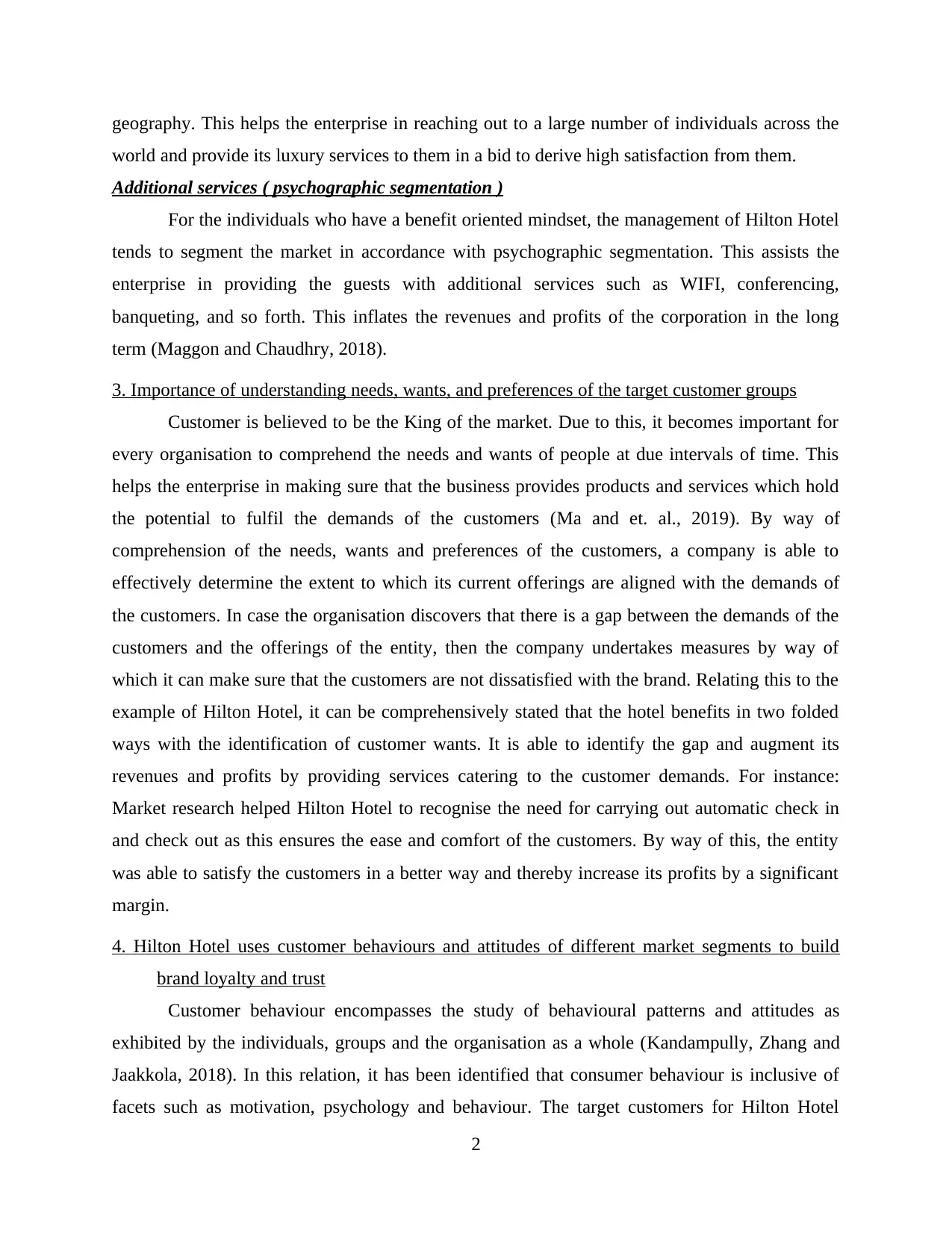
geography. This helps the enterprise in reaching out to a large number of individuals across the
world and provide its luxury services to them in a bid to derive high satisfaction from them.
Additional services ( psychographic segmentation )
For the individuals who have a benefit oriented mindset, the management of Hilton Hotel
tends to segment the market in accordance with psychographic segmentation. This assists the
enterprise in providing the guests with additional services such as WIFI, conferencing,
banqueting, and so forth. This inflates the revenues and profits of the corporation in the long
term (Maggon and Chaudhry, 2018).
3. Importance of understanding needs, wants, and preferences of the target customer groups
Customer is believed to be the King of the market. Due to this, it becomes important for
every organisation to comprehend the needs and wants of people at due intervals of time. This
helps the enterprise in making sure that the business provides products and services which hold
the potential to fulfil the demands of the customers (Ma and et. al., 2019). By way of
comprehension of the needs, wants and preferences of the customers, a company is able to
effectively determine the extent to which its current offerings are aligned with the demands of
the customers. In case the organisation discovers that there is a gap between the demands of the
customers and the offerings of the entity, then the company undertakes measures by way of
which it can make sure that the customers are not dissatisfied with the brand. Relating this to the
example of Hilton Hotel, it can be comprehensively stated that the hotel benefits in two folded
ways with the identification of customer wants. It is able to identify the gap and augment its
revenues and profits by providing services catering to the customer demands. For instance:
Market research helped Hilton Hotel to recognise the need for carrying out automatic check in
and check out as this ensures the ease and comfort of the customers. By way of this, the entity
was able to satisfy the customers in a better way and thereby increase its profits by a significant
margin.
4. Hilton Hotel uses customer behaviours and attitudes of different market segments to build
brand loyalty and trust
Customer behaviour encompasses the study of behavioural patterns and attitudes as
exhibited by the individuals, groups and the organisation as a whole (Kandampully, Zhang and
Jaakkola, 2018). In this relation, it has been identified that consumer behaviour is inclusive of
facets such as motivation, psychology and behaviour. The target customers for Hilton Hotel
2
world and provide its luxury services to them in a bid to derive high satisfaction from them.
Additional services ( psychographic segmentation )
For the individuals who have a benefit oriented mindset, the management of Hilton Hotel
tends to segment the market in accordance with psychographic segmentation. This assists the
enterprise in providing the guests with additional services such as WIFI, conferencing,
banqueting, and so forth. This inflates the revenues and profits of the corporation in the long
term (Maggon and Chaudhry, 2018).
3. Importance of understanding needs, wants, and preferences of the target customer groups
Customer is believed to be the King of the market. Due to this, it becomes important for
every organisation to comprehend the needs and wants of people at due intervals of time. This
helps the enterprise in making sure that the business provides products and services which hold
the potential to fulfil the demands of the customers (Ma and et. al., 2019). By way of
comprehension of the needs, wants and preferences of the customers, a company is able to
effectively determine the extent to which its current offerings are aligned with the demands of
the customers. In case the organisation discovers that there is a gap between the demands of the
customers and the offerings of the entity, then the company undertakes measures by way of
which it can make sure that the customers are not dissatisfied with the brand. Relating this to the
example of Hilton Hotel, it can be comprehensively stated that the hotel benefits in two folded
ways with the identification of customer wants. It is able to identify the gap and augment its
revenues and profits by providing services catering to the customer demands. For instance:
Market research helped Hilton Hotel to recognise the need for carrying out automatic check in
and check out as this ensures the ease and comfort of the customers. By way of this, the entity
was able to satisfy the customers in a better way and thereby increase its profits by a significant
margin.
4. Hilton Hotel uses customer behaviours and attitudes of different market segments to build
brand loyalty and trust
Customer behaviour encompasses the study of behavioural patterns and attitudes as
exhibited by the individuals, groups and the organisation as a whole (Kandampully, Zhang and
Jaakkola, 2018). In this relation, it has been identified that consumer behaviour is inclusive of
facets such as motivation, psychology and behaviour. The target customers for Hilton Hotel
2
Paraphrase This Document
Need a fresh take? Get an instant paraphrase of this document with our AI Paraphraser
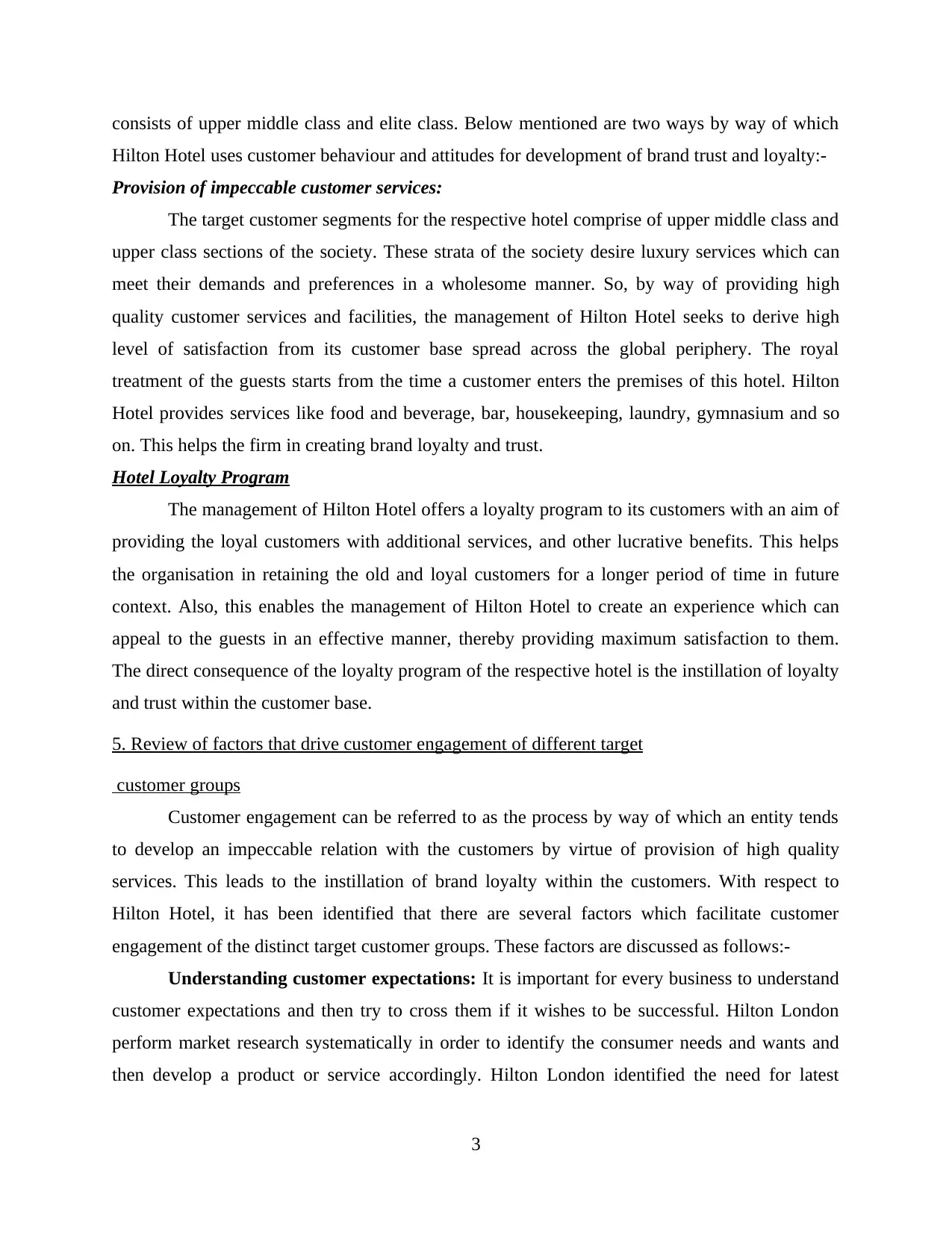
consists of upper middle class and elite class. Below mentioned are two ways by way of which
Hilton Hotel uses customer behaviour and attitudes for development of brand trust and loyalty:-
Provision of impeccable customer services:
The target customer segments for the respective hotel comprise of upper middle class and
upper class sections of the society. These strata of the society desire luxury services which can
meet their demands and preferences in a wholesome manner. So, by way of providing high
quality customer services and facilities, the management of Hilton Hotel seeks to derive high
level of satisfaction from its customer base spread across the global periphery. The royal
treatment of the guests starts from the time a customer enters the premises of this hotel. Hilton
Hotel provides services like food and beverage, bar, housekeeping, laundry, gymnasium and so
on. This helps the firm in creating brand loyalty and trust.
Hotel Loyalty Program
The management of Hilton Hotel offers a loyalty program to its customers with an aim of
providing the loyal customers with additional services, and other lucrative benefits. This helps
the organisation in retaining the old and loyal customers for a longer period of time in future
context. Also, this enables the management of Hilton Hotel to create an experience which can
appeal to the guests in an effective manner, thereby providing maximum satisfaction to them.
The direct consequence of the loyalty program of the respective hotel is the instillation of loyalty
and trust within the customer base.
5. Review of factors that drive customer engagement of different target
customer groups
Customer engagement can be referred to as the process by way of which an entity tends
to develop an impeccable relation with the customers by virtue of provision of high quality
services. This leads to the instillation of brand loyalty within the customers. With respect to
Hilton Hotel, it has been identified that there are several factors which facilitate customer
engagement of the distinct target customer groups. These factors are discussed as follows:-
Understanding customer expectations: It is important for every business to understand
customer expectations and then try to cross them if it wishes to be successful. Hilton London
perform market research systematically in order to identify the consumer needs and wants and
then develop a product or service accordingly. Hilton London identified the need for latest
3
Hilton Hotel uses customer behaviour and attitudes for development of brand trust and loyalty:-
Provision of impeccable customer services:
The target customer segments for the respective hotel comprise of upper middle class and
upper class sections of the society. These strata of the society desire luxury services which can
meet their demands and preferences in a wholesome manner. So, by way of providing high
quality customer services and facilities, the management of Hilton Hotel seeks to derive high
level of satisfaction from its customer base spread across the global periphery. The royal
treatment of the guests starts from the time a customer enters the premises of this hotel. Hilton
Hotel provides services like food and beverage, bar, housekeeping, laundry, gymnasium and so
on. This helps the firm in creating brand loyalty and trust.
Hotel Loyalty Program
The management of Hilton Hotel offers a loyalty program to its customers with an aim of
providing the loyal customers with additional services, and other lucrative benefits. This helps
the organisation in retaining the old and loyal customers for a longer period of time in future
context. Also, this enables the management of Hilton Hotel to create an experience which can
appeal to the guests in an effective manner, thereby providing maximum satisfaction to them.
The direct consequence of the loyalty program of the respective hotel is the instillation of loyalty
and trust within the customer base.
5. Review of factors that drive customer engagement of different target
customer groups
Customer engagement can be referred to as the process by way of which an entity tends
to develop an impeccable relation with the customers by virtue of provision of high quality
services. This leads to the instillation of brand loyalty within the customers. With respect to
Hilton Hotel, it has been identified that there are several factors which facilitate customer
engagement of the distinct target customer groups. These factors are discussed as follows:-
Understanding customer expectations: It is important for every business to understand
customer expectations and then try to cross them if it wishes to be successful. Hilton London
perform market research systematically in order to identify the consumer needs and wants and
then develop a product or service accordingly. Hilton London identified the need for latest
3
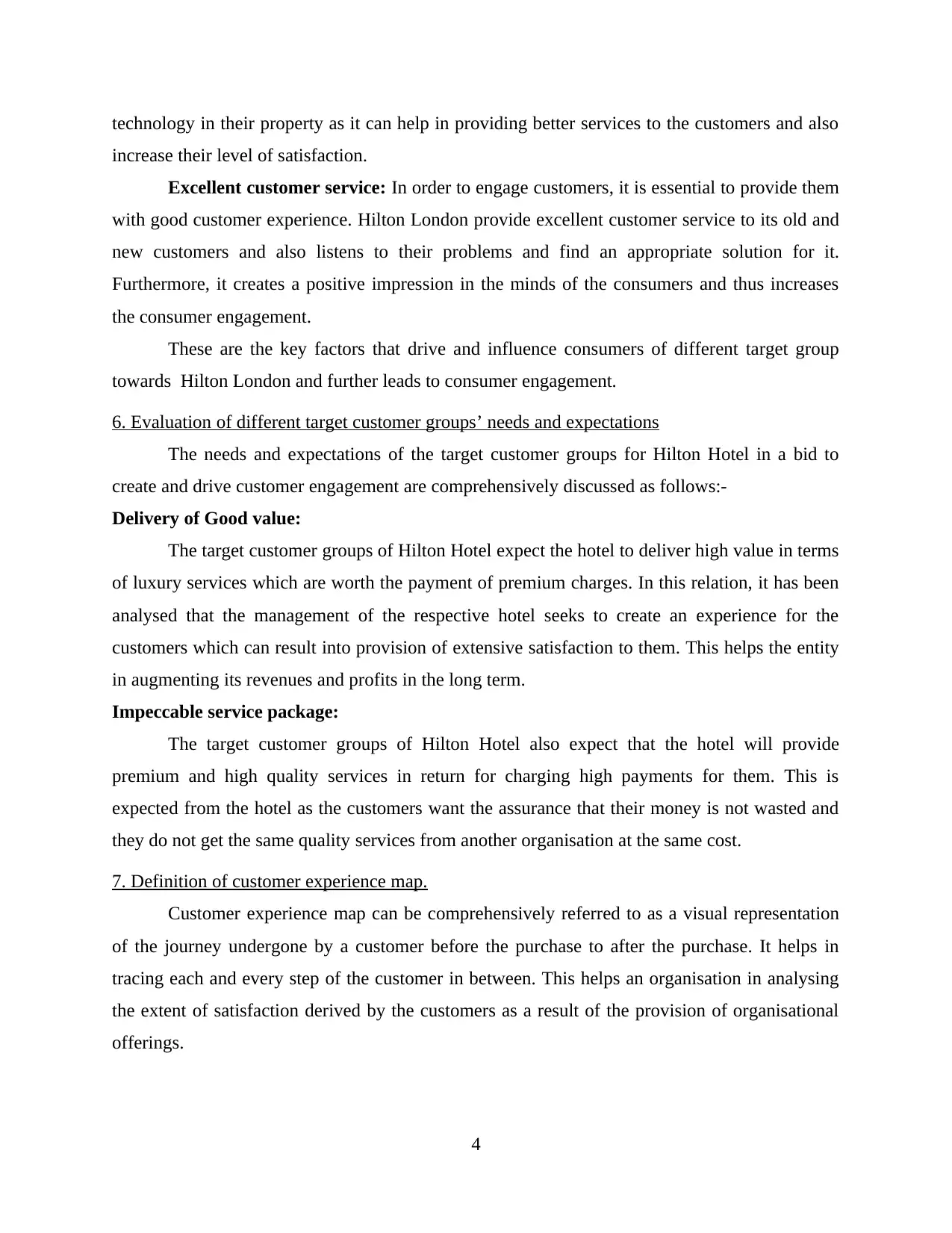
technology in their property as it can help in providing better services to the customers and also
increase their level of satisfaction.
Excellent customer service: In order to engage customers, it is essential to provide them
with good customer experience. Hilton London provide excellent customer service to its old and
new customers and also listens to their problems and find an appropriate solution for it.
Furthermore, it creates a positive impression in the minds of the consumers and thus increases
the consumer engagement.
These are the key factors that drive and influence consumers of different target group
towards Hilton London and further leads to consumer engagement.
6. Evaluation of different target customer groups’ needs and expectations
The needs and expectations of the target customer groups for Hilton Hotel in a bid to
create and drive customer engagement are comprehensively discussed as follows:-
Delivery of Good value:
The target customer groups of Hilton Hotel expect the hotel to deliver high value in terms
of luxury services which are worth the payment of premium charges. In this relation, it has been
analysed that the management of the respective hotel seeks to create an experience for the
customers which can result into provision of extensive satisfaction to them. This helps the entity
in augmenting its revenues and profits in the long term.
Impeccable service package:
The target customer groups of Hilton Hotel also expect that the hotel will provide
premium and high quality services in return for charging high payments for them. This is
expected from the hotel as the customers want the assurance that their money is not wasted and
they do not get the same quality services from another organisation at the same cost.
7. Definition of customer experience map.
Customer experience map can be comprehensively referred to as a visual representation
of the journey undergone by a customer before the purchase to after the purchase. It helps in
tracing each and every step of the customer in between. This helps an organisation in analysing
the extent of satisfaction derived by the customers as a result of the provision of organisational
offerings.
4
increase their level of satisfaction.
Excellent customer service: In order to engage customers, it is essential to provide them
with good customer experience. Hilton London provide excellent customer service to its old and
new customers and also listens to their problems and find an appropriate solution for it.
Furthermore, it creates a positive impression in the minds of the consumers and thus increases
the consumer engagement.
These are the key factors that drive and influence consumers of different target group
towards Hilton London and further leads to consumer engagement.
6. Evaluation of different target customer groups’ needs and expectations
The needs and expectations of the target customer groups for Hilton Hotel in a bid to
create and drive customer engagement are comprehensively discussed as follows:-
Delivery of Good value:
The target customer groups of Hilton Hotel expect the hotel to deliver high value in terms
of luxury services which are worth the payment of premium charges. In this relation, it has been
analysed that the management of the respective hotel seeks to create an experience for the
customers which can result into provision of extensive satisfaction to them. This helps the entity
in augmenting its revenues and profits in the long term.
Impeccable service package:
The target customer groups of Hilton Hotel also expect that the hotel will provide
premium and high quality services in return for charging high payments for them. This is
expected from the hotel as the customers want the assurance that their money is not wasted and
they do not get the same quality services from another organisation at the same cost.
7. Definition of customer experience map.
Customer experience map can be comprehensively referred to as a visual representation
of the journey undergone by a customer before the purchase to after the purchase. It helps in
tracing each and every step of the customer in between. This helps an organisation in analysing
the extent of satisfaction derived by the customers as a result of the provision of organisational
offerings.
4
⊘ This is a preview!⊘
Do you want full access?
Subscribe today to unlock all pages.

Trusted by 1+ million students worldwide
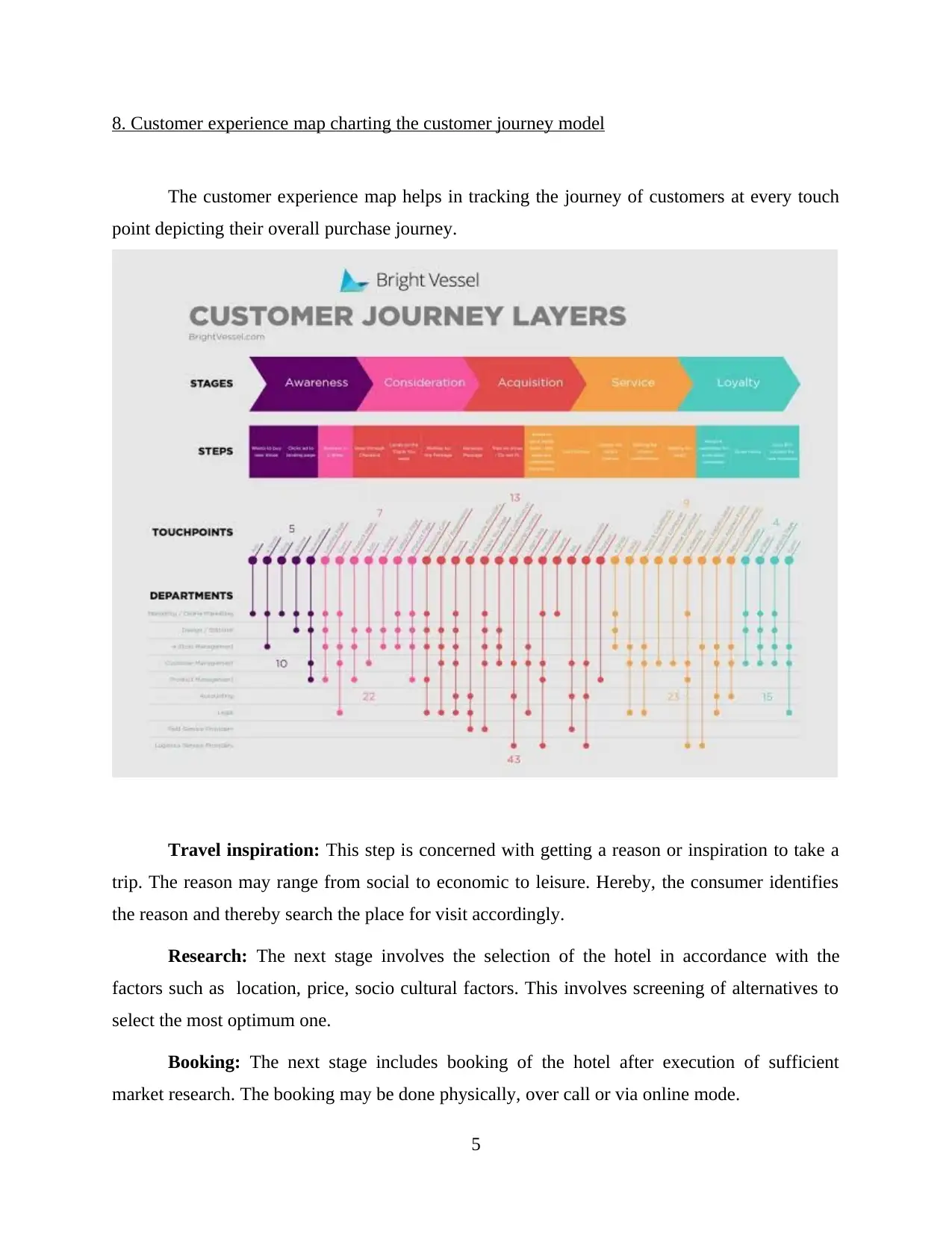
8. Customer experience map charting the customer journey model
The customer experience map helps in tracking the journey of customers at every touch
point depicting their overall purchase journey.
Travel inspiration: This step is concerned with getting a reason or inspiration to take a
trip. The reason may range from social to economic to leisure. Hereby, the consumer identifies
the reason and thereby search the place for visit accordingly.
Research: The next stage involves the selection of the hotel in accordance with the
factors such as location, price, socio cultural factors. This involves screening of alternatives to
select the most optimum one.
Booking: The next stage includes booking of the hotel after execution of sufficient
market research. The booking may be done physically, over call or via online mode.
5
The customer experience map helps in tracking the journey of customers at every touch
point depicting their overall purchase journey.
Travel inspiration: This step is concerned with getting a reason or inspiration to take a
trip. The reason may range from social to economic to leisure. Hereby, the consumer identifies
the reason and thereby search the place for visit accordingly.
Research: The next stage involves the selection of the hotel in accordance with the
factors such as location, price, socio cultural factors. This involves screening of alternatives to
select the most optimum one.
Booking: The next stage includes booking of the hotel after execution of sufficient
market research. The booking may be done physically, over call or via online mode.
5
Paraphrase This Document
Need a fresh take? Get an instant paraphrase of this document with our AI Paraphraser
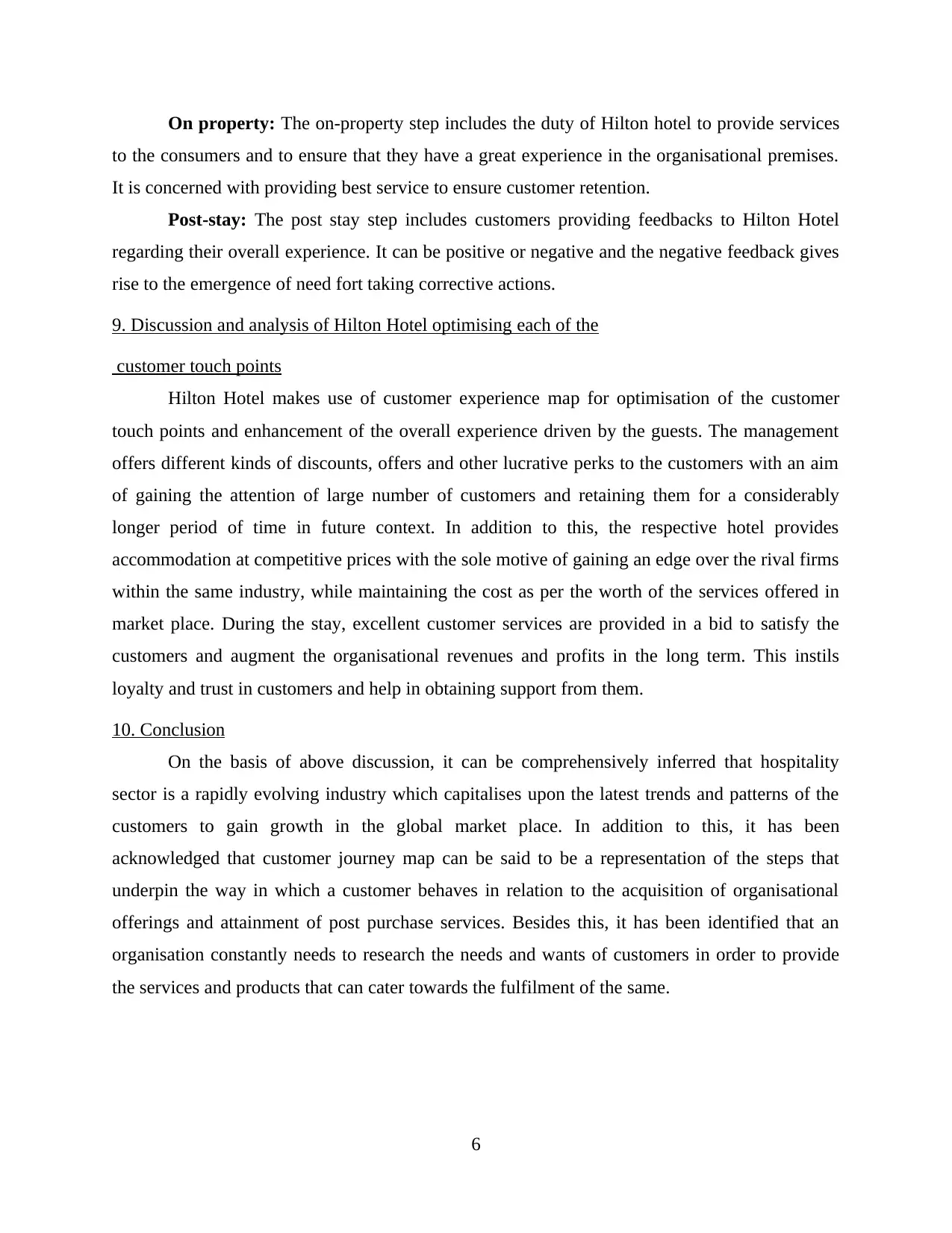
On property: The on-property step includes the duty of Hilton hotel to provide services
to the consumers and to ensure that they have a great experience in the organisational premises.
It is concerned with providing best service to ensure customer retention.
Post-stay: The post stay step includes customers providing feedbacks to Hilton Hotel
regarding their overall experience. It can be positive or negative and the negative feedback gives
rise to the emergence of need fort taking corrective actions.
9. Discussion and analysis of Hilton Hotel optimising each of the
customer touch points
Hilton Hotel makes use of customer experience map for optimisation of the customer
touch points and enhancement of the overall experience driven by the guests. The management
offers different kinds of discounts, offers and other lucrative perks to the customers with an aim
of gaining the attention of large number of customers and retaining them for a considerably
longer period of time in future context. In addition to this, the respective hotel provides
accommodation at competitive prices with the sole motive of gaining an edge over the rival firms
within the same industry, while maintaining the cost as per the worth of the services offered in
market place. During the stay, excellent customer services are provided in a bid to satisfy the
customers and augment the organisational revenues and profits in the long term. This instils
loyalty and trust in customers and help in obtaining support from them.
10. Conclusion
On the basis of above discussion, it can be comprehensively inferred that hospitality
sector is a rapidly evolving industry which capitalises upon the latest trends and patterns of the
customers to gain growth in the global market place. In addition to this, it has been
acknowledged that customer journey map can be said to be a representation of the steps that
underpin the way in which a customer behaves in relation to the acquisition of organisational
offerings and attainment of post purchase services. Besides this, it has been identified that an
organisation constantly needs to research the needs and wants of customers in order to provide
the services and products that can cater towards the fulfilment of the same.
6
to the consumers and to ensure that they have a great experience in the organisational premises.
It is concerned with providing best service to ensure customer retention.
Post-stay: The post stay step includes customers providing feedbacks to Hilton Hotel
regarding their overall experience. It can be positive or negative and the negative feedback gives
rise to the emergence of need fort taking corrective actions.
9. Discussion and analysis of Hilton Hotel optimising each of the
customer touch points
Hilton Hotel makes use of customer experience map for optimisation of the customer
touch points and enhancement of the overall experience driven by the guests. The management
offers different kinds of discounts, offers and other lucrative perks to the customers with an aim
of gaining the attention of large number of customers and retaining them for a considerably
longer period of time in future context. In addition to this, the respective hotel provides
accommodation at competitive prices with the sole motive of gaining an edge over the rival firms
within the same industry, while maintaining the cost as per the worth of the services offered in
market place. During the stay, excellent customer services are provided in a bid to satisfy the
customers and augment the organisational revenues and profits in the long term. This instils
loyalty and trust in customers and help in obtaining support from them.
10. Conclusion
On the basis of above discussion, it can be comprehensively inferred that hospitality
sector is a rapidly evolving industry which capitalises upon the latest trends and patterns of the
customers to gain growth in the global market place. In addition to this, it has been
acknowledged that customer journey map can be said to be a representation of the steps that
underpin the way in which a customer behaves in relation to the acquisition of organisational
offerings and attainment of post purchase services. Besides this, it has been identified that an
organisation constantly needs to research the needs and wants of customers in order to provide
the services and products that can cater towards the fulfilment of the same.
6
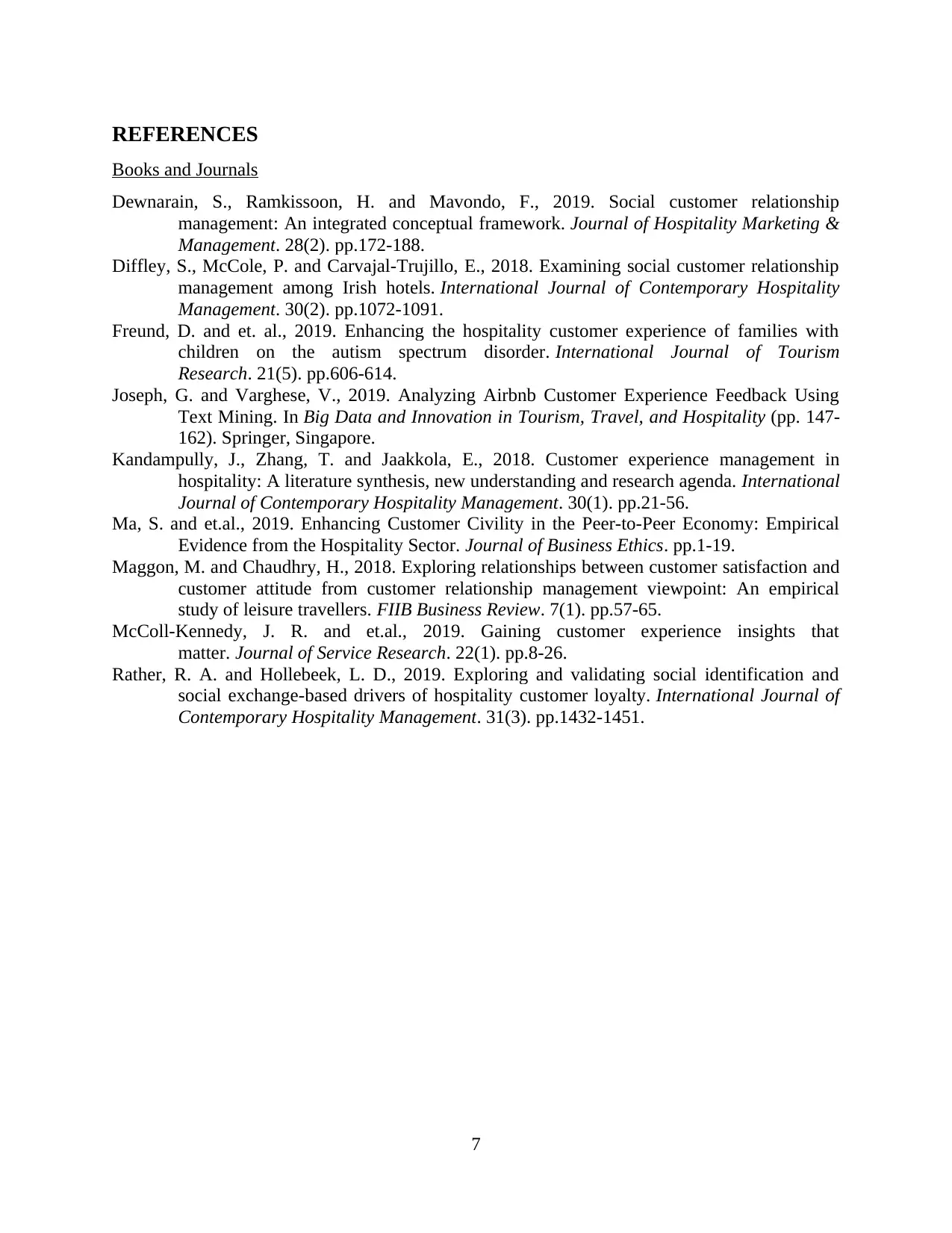
REFERENCES
Books and Journals
Dewnarain, S., Ramkissoon, H. and Mavondo, F., 2019. Social customer relationship
management: An integrated conceptual framework. Journal of Hospitality Marketing &
Management. 28(2). pp.172-188.
Diffley, S., McCole, P. and Carvajal-Trujillo, E., 2018. Examining social customer relationship
management among Irish hotels. International Journal of Contemporary Hospitality
Management. 30(2). pp.1072-1091.
Freund, D. and et. al., 2019. Enhancing the hospitality customer experience of families with
children on the autism spectrum disorder. International Journal of Tourism
Research. 21(5). pp.606-614.
Joseph, G. and Varghese, V., 2019. Analyzing Airbnb Customer Experience Feedback Using
Text Mining. In Big Data and Innovation in Tourism, Travel, and Hospitality (pp. 147-
162). Springer, Singapore.
Kandampully, J., Zhang, T. and Jaakkola, E., 2018. Customer experience management in
hospitality: A literature synthesis, new understanding and research agenda. International
Journal of Contemporary Hospitality Management. 30(1). pp.21-56.
Ma, S. and et.al., 2019. Enhancing Customer Civility in the Peer-to-Peer Economy: Empirical
Evidence from the Hospitality Sector. Journal of Business Ethics. pp.1-19.
Maggon, M. and Chaudhry, H., 2018. Exploring relationships between customer satisfaction and
customer attitude from customer relationship management viewpoint: An empirical
study of leisure travellers. FIIB Business Review. 7(1). pp.57-65.
McColl-Kennedy, J. R. and et.al., 2019. Gaining customer experience insights that
matter. Journal of Service Research. 22(1). pp.8-26.
Rather, R. A. and Hollebeek, L. D., 2019. Exploring and validating social identification and
social exchange-based drivers of hospitality customer loyalty. International Journal of
Contemporary Hospitality Management. 31(3). pp.1432-1451.
7
Books and Journals
Dewnarain, S., Ramkissoon, H. and Mavondo, F., 2019. Social customer relationship
management: An integrated conceptual framework. Journal of Hospitality Marketing &
Management. 28(2). pp.172-188.
Diffley, S., McCole, P. and Carvajal-Trujillo, E., 2018. Examining social customer relationship
management among Irish hotels. International Journal of Contemporary Hospitality
Management. 30(2). pp.1072-1091.
Freund, D. and et. al., 2019. Enhancing the hospitality customer experience of families with
children on the autism spectrum disorder. International Journal of Tourism
Research. 21(5). pp.606-614.
Joseph, G. and Varghese, V., 2019. Analyzing Airbnb Customer Experience Feedback Using
Text Mining. In Big Data and Innovation in Tourism, Travel, and Hospitality (pp. 147-
162). Springer, Singapore.
Kandampully, J., Zhang, T. and Jaakkola, E., 2018. Customer experience management in
hospitality: A literature synthesis, new understanding and research agenda. International
Journal of Contemporary Hospitality Management. 30(1). pp.21-56.
Ma, S. and et.al., 2019. Enhancing Customer Civility in the Peer-to-Peer Economy: Empirical
Evidence from the Hospitality Sector. Journal of Business Ethics. pp.1-19.
Maggon, M. and Chaudhry, H., 2018. Exploring relationships between customer satisfaction and
customer attitude from customer relationship management viewpoint: An empirical
study of leisure travellers. FIIB Business Review. 7(1). pp.57-65.
McColl-Kennedy, J. R. and et.al., 2019. Gaining customer experience insights that
matter. Journal of Service Research. 22(1). pp.8-26.
Rather, R. A. and Hollebeek, L. D., 2019. Exploring and validating social identification and
social exchange-based drivers of hospitality customer loyalty. International Journal of
Contemporary Hospitality Management. 31(3). pp.1432-1451.
7
⊘ This is a preview!⊘
Do you want full access?
Subscribe today to unlock all pages.

Trusted by 1+ million students worldwide
1 out of 9
Related Documents
Your All-in-One AI-Powered Toolkit for Academic Success.
+13062052269
info@desklib.com
Available 24*7 on WhatsApp / Email
![[object Object]](/_next/static/media/star-bottom.7253800d.svg)
Unlock your academic potential
Copyright © 2020–2025 A2Z Services. All Rights Reserved. Developed and managed by ZUCOL.





